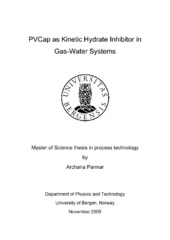| dc.description.abstract | In this work, molecular dynamic (MD) simulations were employed on different model systems of practical and theoretical significance to investigate possible mechanisms of kinetic hydrate inhibition. Water/methane interface structuring and possible precursors to hydrate nucleation have been investigated using a model system of water and methane at different densities. The impact of oligomers, specifically Poly-N-VinylCaprolactam (PVCap) dodecamer, on structuring of water/methane interfaces at different methane densities was investigated utilizing two different sets of partial atomic charges. In yet another system, the effect of high PVCap concentration on water restructuring was also analyzed. Regions of stability for methane hydrate have been investigated using a model system consisting of a slab of hydrate embedded in liquid water. Solvation Model 6 was applied to obtain charges on PVCap atoms using density functional theory with B3LYP and STO-6-31+G** basis set. MM3 force field parameters were used to handle torsional and angle-bending motions. Intermolecular interactions were treated by a combination of Coulomb and Lennard-Jones potentials. Temperature was first controlled by a simple velocity scaling and then towards the end of the simulation run, Nosé-Hoover thermostat was used. Systems containing liquid water and methane showed certain signs of hydrate nucleation. The dissolution of methane into water appeared to increase with methane concentration. PVCap formed hydrogen bonds with water via carbonyl oxygen and hence hindered water reordering needed to build hydrate cages from liquid water. The PVCap behavior was shown to be heavily affected by its concentration in water and distribution of atomic charges. At low concentrations, PVCap preferred the water-methane interface and did not interact with each other, similar to another kinetic inhibitor, PVP (Kvamme et al. 2005). When the liquid PVCap content was high, it evidently modified the interfacial tension of water-methane surface, converting the initially dispersed methane phase into separated bubbles. The PVCap molecules then built a system-wide network that covered the interface between water and methane bubbles. The orientations and interactions of PVCap molecule with other molecules was influenced by the distribution of the partial atomic charges. Charges obtained via Charge Model 4 proved to result in a more reliable behavior than those obtained by means of the Löwdin population analysis. Several of the hydrate-containing systems showed a tendency to melt when in contact with liquid water even at temperatures (200K, 240K) well below the hydrate stability region. This behavior was attributed to the fact that hydrate volume available in a MD experiment is small and lacks the stabilizing presence of bulk. An article involving the work in this thesis is in the process of being written. The findings were presented at the Seventh International Conference of Computational Methods in Sciences and Engineering (ICCMSE 2009), and an extended abstract will appear in its proceedings. | en_US |
